Community Embraces New Word Game at Mid-Year Play Day This past Sunday, families at Takoma Park’s Seventh Annual Mid-Year Play Day had the opportunity to experience OtherWordly for the first time. Our educational language game drew curious children and parents to our table throughout the afternoon. Words in Space Several children gathered around our iPads […]
Read moreTag: apps
 Imploded by the same forces that have disrupted the broader publishing industry, the dictionary business struggles to get a grip on the online/mobile world. “Our research tells us that most people today get their reference information via their computer, tablet, or phone” said Stephen Bullon, Macmillan Education’s Publisher for Dictionaries, “and the message is clear and unambiguous: the future of the dictionary is digital.” (more…)
Imploded by the same forces that have disrupted the broader publishing industry, the dictionary business struggles to get a grip on the online/mobile world. “Our research tells us that most people today get their reference information via their computer, tablet, or phone” said Stephen Bullon, Macmillan Education’s Publisher for Dictionaries, “and the message is clear and unambiguous: the future of the dictionary is digital.” (more…)
 Too many books? Valuable books? If you or your organization has a library of too many books, consider selling them using Amazon.com fulfillment services. Unlike using eBay or the Amazon ‘Marketplace,’ in exchange for various fees, Amazon handles everything: they pick, pack, ship, and provide customer service for your products. No wasting staff time, or rushing to pack up a book and run to the post office every time someone places an order. Here are step-by-step instructions on how to do it… (more…)
Too many books? Valuable books? If you or your organization has a library of too many books, consider selling them using Amazon.com fulfillment services. Unlike using eBay or the Amazon ‘Marketplace,’ in exchange for various fees, Amazon handles everything: they pick, pack, ship, and provide customer service for your products. No wasting staff time, or rushing to pack up a book and run to the post office every time someone places an order. Here are step-by-step instructions on how to do it… (more…)
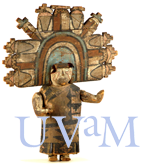 A Hopi doll with painted headdress springs to life, spinning under my finger tips on a new iPad app from the University of Virginia Art Museum (UVaM).
A Hopi doll with painted headdress springs to life, spinning under my finger tips on a new iPad app from the University of Virginia Art Museum (UVaM).
The delightful app presents 19 different objects in 3D, to spin and zoom, providing an immediacy that rivals seeing an object in real life. In fact, it’s better in many ways than peering at an object through a protective case because the objects can be spun through a full 360°, view under bright lighting, at high resolution.
Personal exploration
The free app presents the mobile visitor with a grid of objects (below, left):
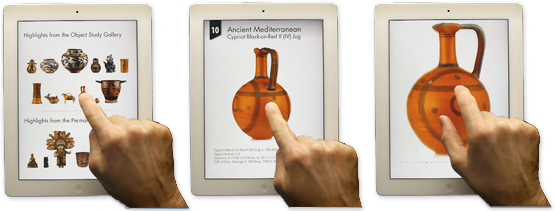
 What was once prohibitively complex and expensive can now be done inexpensively with online testing services. Testing will uncover problems that are confusing for your audience. Here’s a list of vendors to start your research process, and some suggestions.
What was once prohibitively complex and expensive can now be done inexpensively with online testing services. Testing will uncover problems that are confusing for your audience. Here’s a list of vendors to start your research process, and some suggestions.
Three suggestions
For a real-world example on a recent project, designer Ben Snyder said on his blog, “the purpose of the user test is to get feedback about the new design to understand if there are any parts of the website that are confusing to users, and to test the site for hidden bugs that might prevent a user from getting the information they need” or prevent them from completing actions on the site. (more…)
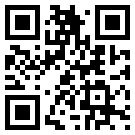 QR codes are a way to send information to mobile devices (e.g., a smartphone) using its camera. You send a short blurb of text, or a web address (URL) by representing it as a code which people photograph from their phone.
QR codes are a way to send information to mobile devices (e.g., a smartphone) using its camera. You send a short blurb of text, or a web address (URL) by representing it as a code which people photograph from their phone.
The codes are easy to generate. Several web sites and software programs will make the codes for you.
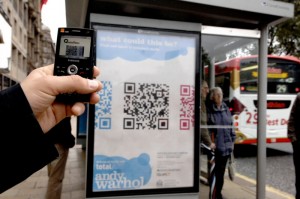 To read the codes, users need a QR reader app to take a snapshot of the code with their device’s camera. The app returns the decoded text or web URL.
To read the codes, users need a QR reader app to take a snapshot of the code with their device’s camera. The app returns the decoded text or web URL.
In the photo at left, a pedestrian takes a photo of a QR code promoting an Andy Warhol show.
There are hundreds of barcode-reader apps (e.g., RedLaser and QuickMark for iOS and Android devices, and the Kaywa reader for dumber smartphones), and code-reading can be included in custom apps, e.g., a museum tour. (more…)

IDEA’s second mobile app, WikiNodes (see app store link) puts the encyclopedic knowledge of Wikipedia at the fingertips of iPad users. Articles are displayed as nodes that can be touched, dragged and spun around — showing the relations between articles and sections of articles. The app is currently featured in Apple’s app store.
Here’s a 30 second demo:
httpvh://www.youtube.com/watch?v=fdiXXxMnqJQ
The app is based on IDEA’s SpicyNodes system for displaying and navigating information using nodes (see SpicyNodes.org). The SpicyNodes approach has great potential for other subjects, from browsing museum collections and archives, to browsing flora & fauna, and many other kinds of linked data.
 The National STEM Video Game Challenge, awarded the $50k grand prize last week to a professional team that did not meet the eligibility criteria.
The National STEM Video Game Challenge, awarded the $50k grand prize last week to a professional team that did not meet the eligibility criteria.
This story came to my attention last week, when I wrote a blog post about a cool online science game for Middle School kids which won the grand prize as part of the contest run by the Joan Ganz Cooney Center at Sesame Workshop (the parent organization of Sesame Street) and E-Line Media. That article briefly mentioned anomalies in the contest, and the Cooney Center sent me an email: “Please take this article down as soon as possible because of a legal issue that is pending.” This made me wonder, is there a scandal on Sesame Street?


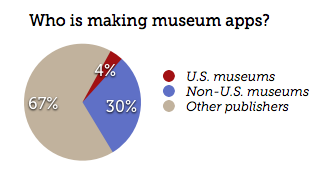 The vast majority of museums are totally ignoring mobile apps.
The vast majority of museums are totally ignoring mobile apps. It is getting easier and cheaper for cultural and scientific organizations make mobile, handheld tours. According to
It is getting easier and cheaper for cultural and scientific organizations make mobile, handheld tours. According to  Today,
Today,